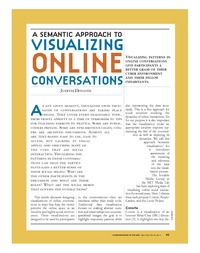A semantic approach to visualizing online conversationsJudith Donath
Erstpublikation in: Communications of the ACM, Vol. 45, No. 4, pp. 48-49
Publikationsdatum:
|
 |
 Diese Seite wurde seit 5 Jahren inhaltlich nicht mehr aktualisiert.
Unter Umständen ist sie nicht mehr aktuell.
Diese Seite wurde seit 5 Jahren inhaltlich nicht mehr aktualisiert.
Unter Umständen ist sie nicht mehr aktuell.
 Zusammenfassungen
Zusammenfassungen
Visualizing patterns in online conversations give participants a better grasp of their cyber environment and their fellow inhabitants.
Von Judith Donath im Text A semantic approach to visualizing online conversations (2002)  In a real-world classroom, teachers can easily observe the current state of social interactions and react as they see fit. In the virtual settings of online discussions, this is much harder. There is research into tools which might help teachers, but such tools have not as of yet become commonplace and are not yet integrated into most learning management systems and computer-medicated communication platforms. This brief paper presents three projects by the Sociable Media Group at the MIT Media Lab dealing with visualizing online social interactions. Though the focus of these projects was not on interactions in the context of learning, the approaches are of interest to online interactions by learners. This review covers two of the three projects in the following paragraphs.
In a real-world classroom, teachers can easily observe the current state of social interactions and react as they see fit. In the virtual settings of online discussions, this is much harder. There is research into tools which might help teachers, but such tools have not as of yet become commonplace and are not yet integrated into most learning management systems and computer-medicated communication platforms. This brief paper presents three projects by the Sociable Media Group at the MIT Media Lab dealing with visualizing online social interactions. Though the focus of these projects was not on interactions in the context of learning, the approaches are of interest to online interactions by learners. This review covers two of the three projects in the following paragraphs.The principle underlying the three projects it the idea of "semantic visualization". That is, the visualizations explicitly introduce assessments of the meaning and relevance of the data. While most visualization try to present themselves as "neutral" and "objective" displays of purely quantitative data, the author argues that there is no truly neutral display and that it is better to make the emotional qualitative semantic visually explicit.
The first project, Coterie, visualizes chat room activity using animations. Participants are represented as colored ovals that bounce and become brighter when that person speaks. Coterie uses content heuristics to determine threads of discussion, and visualizes these threads as well. The idea is to convey to the user the feel of the conversation itself - coherent discussions have a central core in the display, whereas non-coherent conversations are scattered. The second project, PeopleGarden, uses a garden metaphor to visualize participation in a discussion forum. Participants are rendered as flowers: The longer they have been active, the higher the stem; the more they have posted, the more petals. The image conveys a clear sense of how many people are active, how many are lurkers, or who is dominating the conversation.
These kinds of visualizations focus on providing the viewer with a qualitative sense of what is going on in a virtual discussion setting, synchronous or asynchronous. Though their context is not learning per se, they offer inspirations that have been taken up by other projects in the educational settings. One avenue for future research could be the integration of the visualization with their underlying conversational message and clusters of messages, so that viewers could navigate through the visualization to individual messages for qualitative content analysis. Another avenue for future research would be studies of user acceptance and usage of such visualizations to determine how teachers would use such tools.
Quelle: [www.elearning-reviews.org]
 Dieser Text erwähnt ...
Dieser Text erwähnt ...
 Personen KB IB clear | Edward R. Tufte | ||||||||||||||||||
 Begriffe KB IB clear |  Chat Chat chat
, Computervermittelte Kommunikationcomputer mediated communication
, Instant MessagingInstant Messaging
, chat
, Computervermittelte Kommunikationcomputer mediated communication
, Instant MessagingInstant Messaging
,  Kommunikation Kommunikation communication
, communication
,  MIT
, Musterpattern
, NewsgroupsNewsgroups
, MIT
, Musterpattern
, NewsgroupsNewsgroups
,  Visualisierung Visualisierung visualization visualization
| ||||||||||||||||||
 Bücher |
|
 Tagcloud
Tagcloud
 Zitationsgraph (Beta-Test mit vis.js)
Zitationsgraph (Beta-Test mit vis.js)
 Anderswo finden
Anderswo finden
 Volltext dieses Dokuments
Volltext dieses Dokuments
 |  A semantic approach to visualizing online conversations: Artikel als Volltext ( A semantic approach to visualizing online conversations: Artikel als Volltext ( : :  , 202 kByte; , 202 kByte;  : :  2020-11-28) 2020-11-28) |
 Anderswo suchen
Anderswo suchen 
 Beat und dieser Text
Beat und dieser Text
Beat war Co-Leiter des ICT-Kompetenzzentrums TOP während er Dieser Text ins Biblionetz aufgenommen hat. Die bisher letzte Bearbeitung erfolgte während seiner Zeit am Institut für Medien und Schule. Beat besitzt kein physisches, aber ein digitales Exemplar. Eine digitale Version ist auf dem Internet verfügbar (s.o.). Es gibt bisher nur wenige Objekte im Biblionetz, die dieses Werk zitieren.










 Biblionetz-History
Biblionetz-History